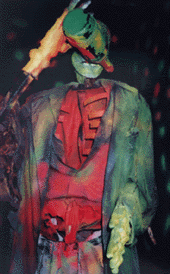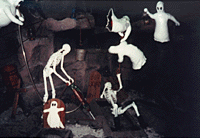

 Afraid of the dark?
Afraid of the dark?When it comes to amusement parks, the carousel's fine with its candy
colors, and the roller coaster dandy in all its varieties. But give me
a dusty, dingy dark ride over them any day. That's right, the lowly
dark
And for me, they are an object of 
Some 23 years later, in the course of my research on dark rides, I
came across a photo of the Wacky Shack, a second-generation photocopy
as blurred as my memory of it. It was at once a revelation and an
explanation for all the energy I'd spent researching such ignoble
attractions. Nothing comes from
It now seems perfectly reasonable that I should have been indelibly impressed with the dark rides at Dorney Park. The Bucket O' Blood, a pirate ghost ship emblazoned with skulls and crossbones, and amplified by the relentless wash of the sea and creak of shivering timbers; the Gold Mine, a dark walk-through whose shadowed entrance both beckoned and disturbed me and whose Boot Hill, a gravelly mound complete with protruding horse hooves and wagon wheels, awakened my fear of being buried alive; Journey to the Center of the Earth, a tunneled boat ride into a netherworld guarded by listless yellow octopi and hairy spiders. My fear of these tawdry spectacles faded over the years, of course, replaced first by scorn, then indifference, and finally nostalgia. That I should now be so committed to documenting and understanding similar rides seems eerily inevitable.
To some extent, my continued interest in these shabby dark rides
embarrasses me. After all, having a taste for dark rides is not unlike
having a secret fetish for other cultural dreck, like Ed Wood movies or
soft-core bondage magazines featuring Bettie Page. But we have reached
that decadent point in the century when it is 
But I seek to elevate the dark ride above the garbage heap of popular culture by allowing it to transcend itself. In the dark ride I see the lost stage for a medieval mystery play, where we get to be Jesus, busting into the inferno and making our way through a "Harrowing of Hell." I see the crumbling skeletons who skipped through the dance of death during the plague years. I see the fairground waxworks and torture chambers of the secularized Age of Reason, which incited our taste for goosebumps and gothic chills. The dark ride's made of the stuff of Hollywood's Golden Age of Corn: 3-D, joy buzzers, gimmicks and gizmos. And it points to Western civilization's attempts to escape reality with shocks and sensations that surpass the real thing.
![[ skew ]](/home.gif)